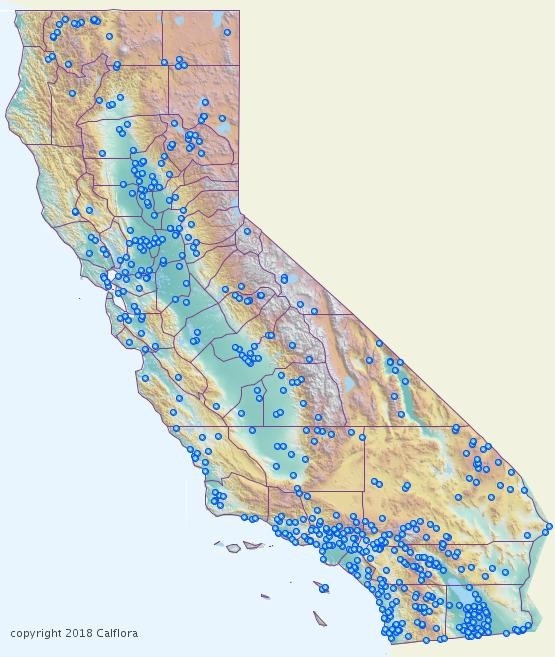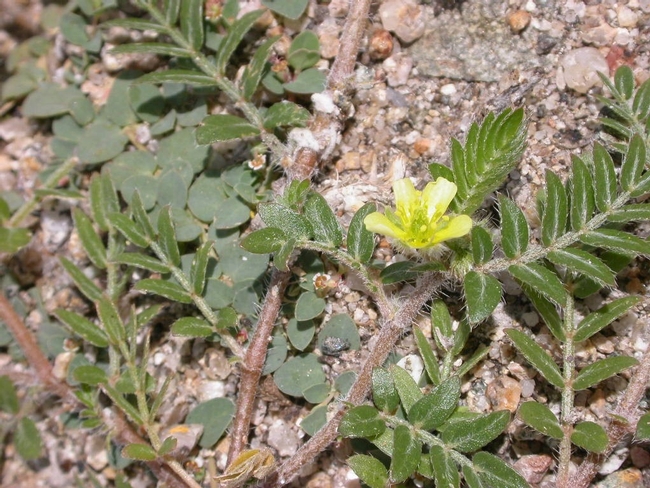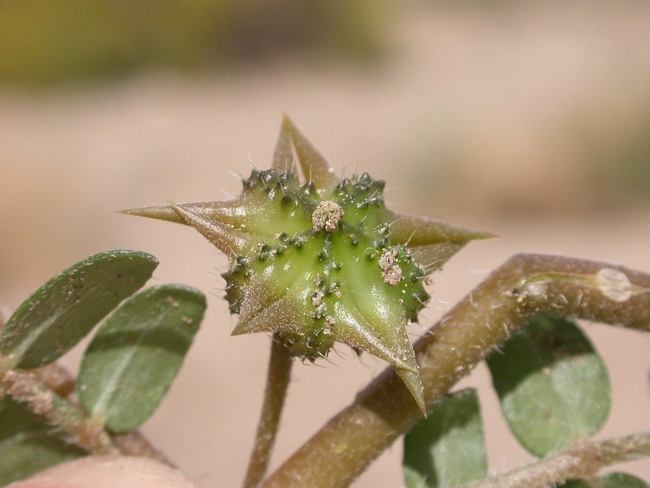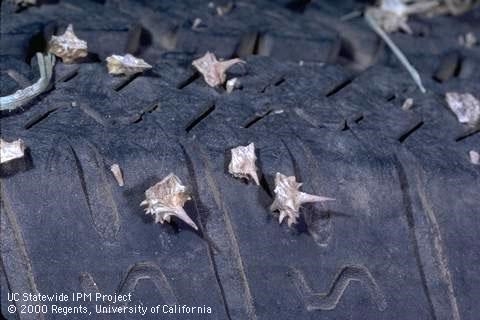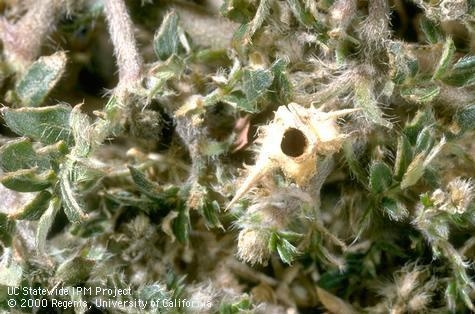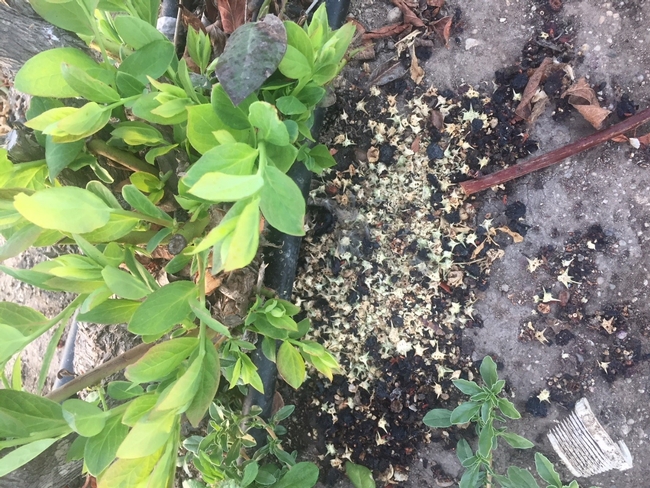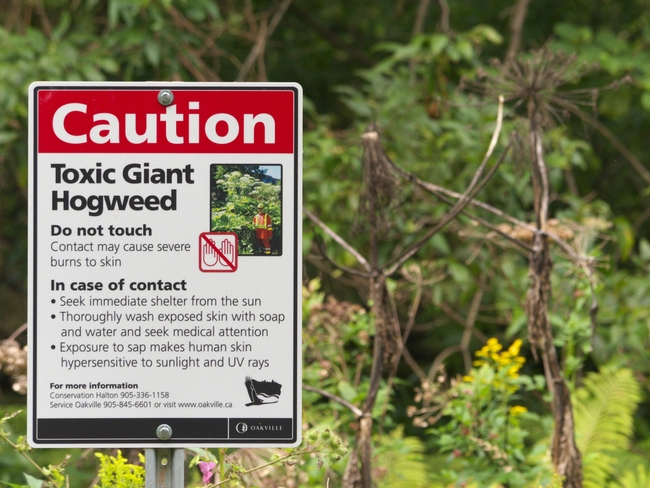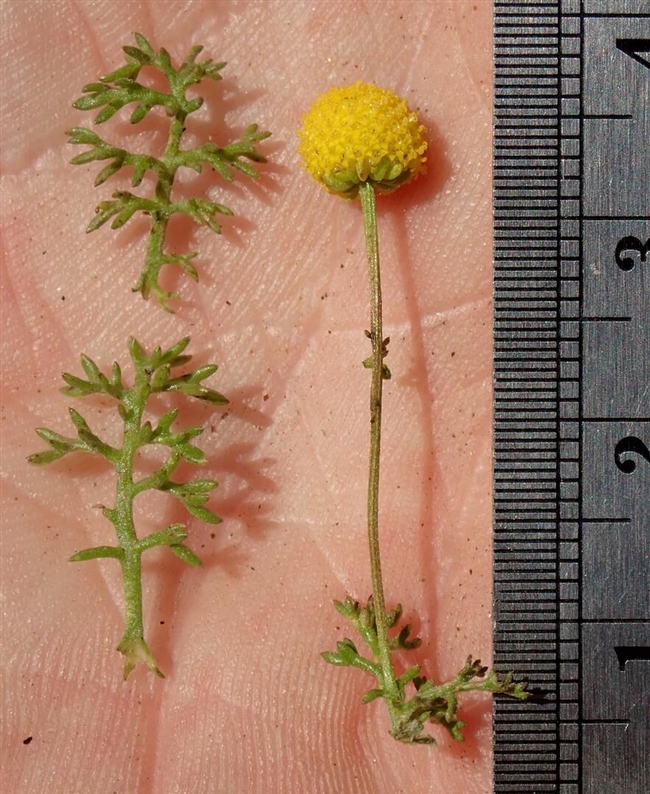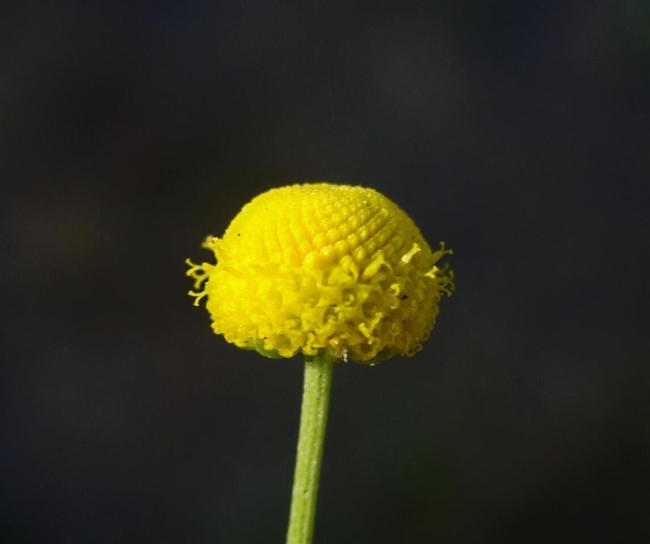
Posts Tagged: invasives
Shot Hole and Other Invasives to Know and Understand
Invasive species are arriving in California with increasing frequency. The best time to stop them is before they arrive, and federal, state and local agencies are keeping their eyes out for new arrivals and threats on the horizon. When they do arrive, Early Detection and Rapid Response is critical to their management. Many detections are made by individuals not associated with any agency or university, and through community/participatory science programs, almost anyone can help to spot the next invasive.
The 2023 Invasive Species Lunchtime Talks all took place via Zoom Webinar from noon to 1:00 p.m. from Monday, June 5 through Friday, June 9. All of the sessions were recorded and can be viewed at https://ucanr.edu/sites/invasivelunch/2023.

shot hole borer damage to wood
Puncturevine Raises its Spikey Head
The following article is from the UC ANR Integrated Pest Management website, authored by Cheryl Wilen.
http://ipm.ucanr.edu/PMG/PESTNOTES/pn74128.html
Puncturevine (Tribulus terrestris) is an aptly named summer annual found widely in California. Native to southern Europe, it can grow under a wide range of conditions, but its success is likely due to its ability to thrive in hot and dry conditions where other plants cannot. It can be a major problem in orchards, pastures, turf, and along roadsides and ditch banks. Although it is known to be toxic to sheep, its main weedy characteristic, as indicated by its common names of puncturevine or caltrop, is its spiky seedpods. (A caltrop is a metal device, used to deter passage by vehicles with pneumatic tires or the hooves of horses; it has four projecting spikes so arranged that when three of the spikes are on the ground, the fourth points upward to poke a tire or hoof.) The seeds of puncturevine are enclosed in a hard caltrop-like case that can injure livestock, people, and pets when stepped on and can even puncture bicycle tires. Another common name is "goathead." Growing up in Fresno it was always a problem with bike tires. It seemed that more time was spent tire repairing than riding the bike.
It's distribution is pretty much throughout California and seems more concentrated in Southern California. There have been more calls recently about the plant, but it has been a common complaint for many years.
https://www.calflora.org/cgi-bin/species_query.cgi?where-calrecnum=8024
IDENTIFICATION AND LIFE CYCLE
Puncturevine is a summer annual broadleaf weed that generally grows low to the ground forming dense mats 2 to 5 feet in diameter. The stems radiate out from a central point at the taproot. The plant does not root from the stems. The hairy leaves are opposite each other and divided into four to eight pairs of leaflets that are also opposite each other. Yellow flowers up to 1/2 inch wide with five petals are found in the leaf axils. After the flower is pollinated, a seedpod forms that is a cluster of five flat spiny burrs containing up to five seeds. As the seedpod matures, it turns gray or tan, gets very hard and breaks apart so that the individual spikes, or burrs, can stick into passing animals and tires. These burrs disperse by adhering to tires, shoes and clothing of people, and the fur, feathers, or feet of animals.
Flower
Burr
Puncturevine germinates in the spring and summer from seeds produced the previous year. Good soil moisture and warm temperatures are needed for germination, but after the plant is established it can tolerate dry soils due to its rapidly produced deep taproot. The plant may start flowering within 3 weeks of germination and flowering will continue throughout the summer. Seeds are primarily dormant in the first season, but may germinate the next spring. Seeds may remain viable in the soil for up to five years. Puncturevine plants cannot tolerate freezing temperatures.
IMPACT
A typical puncturevine plant will produce 200 to 5,000 seeds during one growing season, depending on available soil moisture and other environmental factors. These seeds and those that did not germinate from previous seasons will contribute to the potential weed population the following year.
With its deep taproot, puncturevine competes aggressively for water and nutrients in tree and field crops and turf. Puncturevine in hay will markedly reduce the quality of the product.
When allowed to grow unchecked, puncturevine will develop into a thick mat, hiding the sharp burrs. Even under limited growth conditions, puncturevine's prolific production of the seed burrs creates dangerous conditions for livestock, people, and pets.
Grazing livestock in areas infested with puncturevine is not recommended. The sharp spines of the seed burr can injure the mouth and digestive tract or feet of animals. Puncturevine can be particularly toxic to sheep, causing sensitivity to light resulting in skin lesions and swelling of ears and lips. Severe effects include blindness, necrosis of skin, loss of lips and ears, and death in young animals. Additionally, puncturevine may contribute to nitrate poisoning in sheep and cattle. Symptoms of nitrate poisoning include labored breathing, staggering, tongue and the white of the eyes turning blue, and loss of appetite.
Puncturing Vine
MANAGEMENT
Long-term control of puncturevine can be achieved by reducing the amount of seeds in the soil. This is best accomplished by removing plants before they produce seeds (i.e., before or at flowering) and continuing to do so over several years. Burrs that have dropped after removing the plant may be collected and removed by sweeping or raking the ground. Even patting the ground with a piece of carpet will help collect the burrs. Biological control from two introduced weevils is also very effective, but there may be resurgences every few years as the number of the weevils decline along with the population of the puncturevine.
The primary method of management for puncturevine in the home landscape and garden is removal of seedlings and older plants by hand or hoeing, taking care to also remove any burrs that fall off the plant. Avoid bringing puncturevine into uninfested areas on shoes and the wheels of mowers or carts.
Cultural and Mechanical Control
In most situations, puncturevine is best controlled by hand removal or by hoeing to cut the plant off at its taproot. Monitoring the area and removing the weed throughout the late spring and into the summer will greatly reduce the impact of the weed the next year. Shallow tilling (about 1 inch deep) of seedlings or small plants can be effective in larger areas. Deeper tilling is not recommended since this may bury seeds and they may be able to germinate for several years afterwards. Hand removal, hoeing, or cultivation should be initiated prior to flowering and seed production. Mowing is not an effective method of control since the plant grows low to the ground.
Mulches can be used to control common puncturevine in ornamental plantings, orchards, vineyards, vegetable crops, and gardens, if they screen out all light. To be effective, organic mulches should be at least 3 inches thick. However, puncturevine burrs that fall onto mulch surfaces can establish on the mulch surface due to the puncturevine's deep taproot. Synthetic mulches, which screen out light and provide a physical barrier to seedling development, also work well.
Aeration of compacted sites and planting competitive desirable plants can also reduce the impact of puncturevine by making the area more favorable for the growth of the desired plants and reducing resources available to the weed.
Biological Control
Two weevils, Microlarinus lareynii and M. lypriformis, native to India, France, and Italy, were introduced into the United States as biocontrol agents in 1961. Microlarinus lareynii is a seed weevil that deposits its eggs in the immature burr or flower bud and the larvae feed on and destroy the seeds before they pupate and emerge as adults, disperse, and start the cycle over again. Generation time is 19 to 24 days in the summer in southern California. Microlarinus lypriformis is a stem weevil that has a similar life cycle except that it lays its eggs in the undersides of stems, branches, and the root crown. The larvae tunnel in the pith where they feed and pupate. The adults emerge from holes chewed in the upper surfaces of the stems, branches, and crowns. Adults of both species overwinter in plant debris. Although the stem weevil is slightly more effective than the seed weevil when each is used alone, the weevils are most effective if used together and the puncturevine is moisture-stressed.
Both species of weevils are available for purchase from biological control suppliers but purchase and release is not generally recommended because weevils collected from other areas may not survive at your location. In most California counties where releases would be beneficial, county agricultural commissioners have release programs or can direct you to collection sites where you may be able to collect them yourself. Contact your county agricultural commissioner's office for more information.
Emergence hole of the seed weevil, Microlarinus lareynii, in a puncturevine seed capsule.
Chemical Control
Chemical control is generally not necessary for the control of puncturevine in the home landscape. However, in large areas, or places where there was a heavy infestation in previous years so that it's difficult to remove by hand, hoeing, or tilling, herbicides may be used to control puncturevine.
There are few preemergent herbicides that are effective. Products containing oryzalin, benefin, or trifluralin will provide partial control of germinating seeds. These must be applied prior to germination (late winter to midspring).
After plants have emerged from the soil (postemergent), products containing 2,4-D, glyphosate, and dicamba are effective on puncturevine. The smaller or younger the plant, the better the postemergent herbicides work. Dicamba and 2,4-D will injure most broadleaf plants so it is important that they only be applied to the weeds and drift is minimized. They can be applied to lawns without injuring the desired grass. Glyphosate will kill or injure most plants so it should only be used as spot treatments or on solid stands of the weed.
Mouse collection of tasty puncturevine seeds. Thanks to KenGerry
Giant Hogweed?
Invasive plants don't get much coverage in the news, especially at the state and national level. As I've argued previously, this lack of media attention is a problem when it comes to motivating the public and political players into proactively funding invasive plant management and mitigating impacts to human health, infrastructure, and natural resources. Admittedly, as a weed scientist, I'm biased on the issue.
However, sometimes there is a particular plant that is just so terrifying that it lends itself to coverage in a major news outlet, as was the case for this article about giant hogweed (Heracleum mantegazzianum) by Caitlin O'Kane on CBS news last month: "Giant hogweed, plant that causes blindness and third-degree burns, discovered in Virginia." As the headline suggests, this is a plant you should keep a safe distance from if you are unlucky enough to come across it. Just in case you're thinking that this is just sensationalism, there's a page on Snopes that confirms the assertions about giant hogweed's dangerous sap (and also confirms its place in popular culture). I won't provide a direct link here, but a simple Google search of "giant hogweed" turns up some images of what look like very painful giant hogweed injuries. The photograph below was taken by Gavin Edmondstone:
Giant hogweed is native to the Caucasus region and southwest Asia, and is presently found in Europe, Canada, the United States, Australia, and New Zealand, where it was likely introduced as an ornamental for its showy inflorescence. Apparently it was a well known nuisance in Britain, so much so that the band Genesis released the ominous song "Return of the Giant Hogweed" on their 1971 album Nursery Cryme:
"Turn and run
Nothing can stop them
Around every river and canal their power is growing..." (Google the song title for the complete lyrics- they are fantastic! And strangely factual...)
Here in the US, giant hogweed is mostly found in New England and the Pacific Northwest. As the article suggests, giant hogweed has expanded down the east coast and was recently discovered for the first time in Virginia. Over on the west coast, it has made it as far south as northwestern Oregon. Californians should be on the lookout however, as we do share some similar habitats with Oregon, particularly in the northern part of the state. California also has a native congener called "cowparsnip" (Heracleum maximum), suggesting that suitable habitats do exist across the state.
For those involved with management of this plant, a great resource with information on controlling giant hogweed can be found in DiTomaso et al. (2013) Weed Control in Natural Areas in the Western United States, as well as several state conservation webpages. Before embarking on control, be careful not to confuse with natives that may look similar- your local county Natural Resources Advisor can be of great help in correctly identifying invasive plants. And it should go without saying, but given the potential for painful injury, this is a plant you may want to enlist the help of professionals with if you have it on your property.
As the band Genesis proclaims:
We must destroy them
They infiltrate each city with their thick dark warning odor
They seem immune to all our herbicidal battering"
Now if we could just get some similar coverage in the press or popular culture for our less glamorous but equally terrifying invasive grasses...

giant hogweed1
Stinknet Is a Weed?
This is a Wilen repost: //ucanr.edu/blogs/blogcore/postdetail.cfm?postnum=27499
I recently attended a Santa Ana River - Orange County Weed Management Area (SAROCWMA) meeting and there was the opportunity for participants to update the group about new invasive plants as well as give an update on management of these and others. During the discussion, Ron Vanderhoff from the Orange County Native Plant Society (OC-CNPS), reported on new findings of a plant I never heard of. In fact, when they group was talking about it, I wasn't sure if I heard the name right.
The plant is called stinknet (Oncosiphon piluliferum), which to me sounds like a game played by 10 year olds. However, the OC-CNPS considers it an emerging invasive weed (http://www.occnps.org/PDF/HYS-Oncosiphon-piluliferum.pdf). On the California Invasive Plant Council's weedmapper, it was first reported in the Orange Co. in 2003 but was in San Diego Co. as early as 1998 and Riverside Co. in 1981. According to the USDA-NRCS plants database, it has a limited distribution in the U.S., being found only in Orange, Riverside, and San Diego Counties in California and Maricopa, Pinal, and Yavapai Counties in Arizona. However, Cal-Flora has unconfirmed sightings of it in San Bernardino, Imperial, and Kern Counties.

Stinknet or globe chamomile is a relatively small annual plant that could easily be confused with the turf and landscape weed pineappleweed http://ipm.ucanr.edu/PMG/WEEDS/pineapple_weed.html until you smell it. Pineappleweed flowers have a pleasant sweet smell while, as you may guess from the name, stinknet has the opposite odor. It is most noticeable when flowering (March to July in S. California) so now is a good time to spot it.



All photos by and courtesy of Ron Vanderhoff
Although it is not listed as noxious weed, land managers should still be on the lookout for it especially in along the coast and inland. It can be particularly damaging to in coastal sage scrub where because of its tendency to fill in open spaces, it can reduce growth of other native annuals and impact animals that depend on the openings in these areas.
P.S. Stinkweed should be susceptible to standard weed management practices. Ben

stinknet weed
Summer time and the livin is eatin.
Summer—it's a time for swimming, BBQs, camping, and eating invasive species
Last week during California Invasive Species Action Week (June 2 – June 10), we highlighted several pests, but there are many more invasive species out there. Now that you know about them, share your knowledge of invasive species with others. And no matter what your summer plans, here are some things YOU can do about invasive species from the California Department of Fish and Wildlife and California Department of Food and Agriculture.
YOU: I'M TRAVELLING TO AMAZING PLACES
- Learn what plants and animals you could bring into California.
- Don't pack a pest! Declare all food and agricultural items from other states or countries.
- Find out which species are threats to California.
- Learn about California's invasive plants.
- Avoid spreading forest pests: buy your firewood where you burn it.
YOU: I'LL BE WORKING IN MY GARDEN
- Remove invasive plants from your property.
- Select native or non-invasive plants for your garden.
- Use only certified weed-free forage, hay, seed, mulch, soil, and gravel.
- Learn alternatives to releasing unwanted fish, aquatic plants, and other pets.
- Monitor plants and trees for symptoms of infestations and disease.
- Learn about California's invasive plants.
- Have you spotted an invasive species? Tell us where by reporting your sighting.
YOU: I'LL BE NEAR THE WATER OR ON A BOAT
- Join the statewide citizen science effort to monitor for quagga mussels.
- Join the iNaturalist project, California Nerodia Watch, and help us find Nerodia watersnakes.
- Make sure to Clean, Drain, and Dry (PDF) your boat after each outing.
- Learn alternatives to releasing unwanted fish, aquatic plants, and other pets.
- Visit your favorite local, state, or national park, ecological reserve, recreational area, or nature center and ask about their volunteer programs.
- Learn about California's invasive plants.
- Have you spotted an invasive species? Tell us where by reporting your sighting.
YOU: I'LL BE OUT AND ABOUT CAMPING, HIKING, OR RIDING HORSES
- Use only certified weed-free forage, hay, seed, mulch, soil, and gravel.
- Avoid spreading forest pests: buy your firewood where you burn it.
- Prevent the spread of plant pathogens that damage and kill California's native plants and trees.
- Learn about California's invasive plants.
- Visit your favorite local, state, or national park, ecological reserve, recreational area, or nature center and ask about their volunteer programs.
- Have you spotted an invasive species? Tell us where by reporting your sighting.
YOU: I'LL DEFINITELY CONTINUE TO LEARN ABOUT INVASIVES
- Get to know your local invaders.
- Learn about California's invasive plants.
- Find out which species are threats to California.
- Learn alternatives to releasing unwanted fish, aquatic plants, and other pets.
- Eat them. Yum. Check out these websites to find out who is edible and how to prepare them.
- Invasive-eats.com (California-specific)
- Invasivore.org (under construction but hopefully back soon)
- EatTheWeeds.com
- EatTheInvaders.org
If you missed it this year, help in the fight next year by learning and participating during California Invasive Species Action Week.
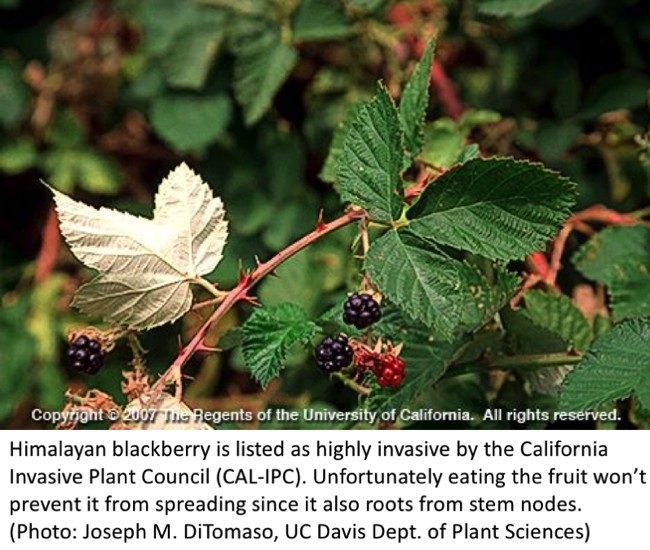
himalayan blackberry
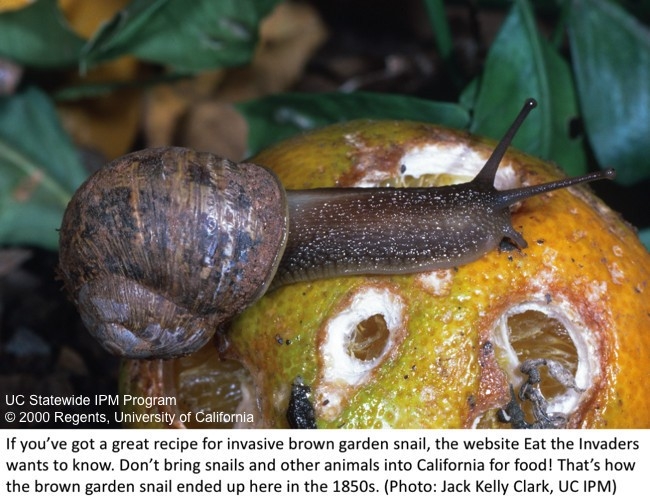
brown garden snail
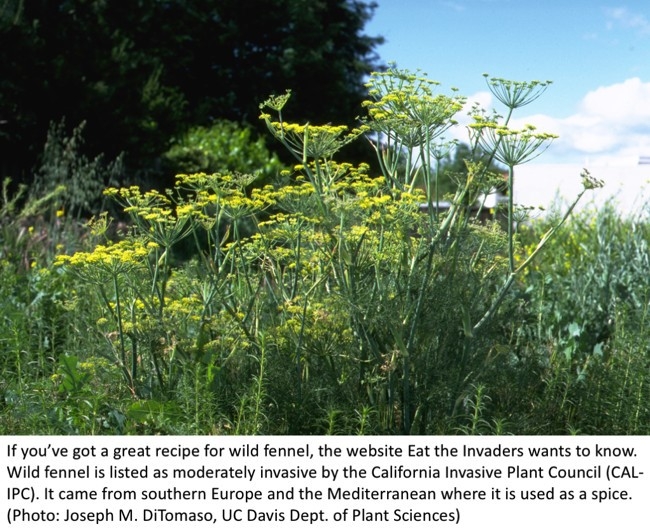
fennel

